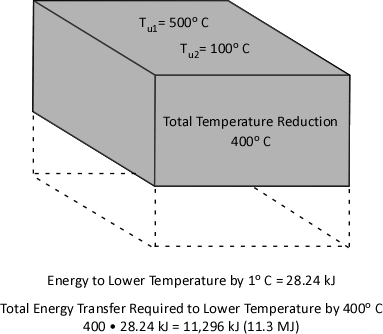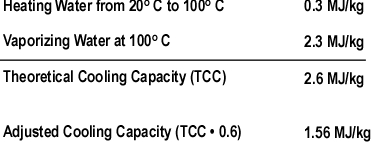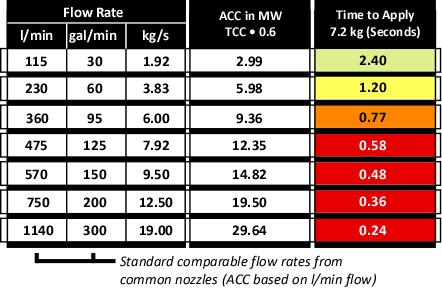Gas Cooling: Part 2
In a compartment fire, the upper layer can present significant hazards to firefighters, including potential for ignition and energy transfer). My last post, Gas Cooling, began an examination of the science behind gas cooling, application of water fog into the upper layer to reduce the potential for ignition and thermal hazards presented by the hot gases.
Figure 1. Energy Transfer Required for Cooling

With a specific heat of 4.2 kJ/kg and latent heat of vaporization of 2260 kJ/kg, it takes considerable energy to raise the temperature of water to its boiling point of 100o C and change it from liquid to gas phase steam. Smoke on the other hand has a specific heat of 1.0 kJ/kg, indicating that in comparison with water; much less energy is required to change its temperature. As explained in Gas Cooling, 11.3 MJ must be transferred from the upper layer of this compartment to water applied for cooling in order to lower the temperature of the upper layer in a compartment from 500o C to 100o C (see Figure 1). It is important to remember that the energy required to cool the upper layer is dependent on the mass of hot smoke and air in the upper layer. This value will vary with the size of the compartment and the temperature of the hot gases.
When starting out on this examination of gas cooling, we posed two questions:
- How much water is required to cool the upper layer from 500o C to 100o C?
- Why doesn’t the volume of the upper layer increase when water applied to cool the hot gases is turned to steam?
The answers to these questions are interrelated. First, let’s look at the amount of water required.
Water Required for Cooling
When water is applied for fire control and extinguishment, energy is transferred from materials that have a temperature higher than that of the water to raise the temperature of the water and to change it from liquid phase to gas phase.
The theoretical cooling capacity (TCC) of water is 2.6 MJ/kg. This value is based on heating a kilogram of water from 20o C to 100o C (0.3 MJ/kg) and vaporizing it completely into steam (2.3 MJ/kg).
Dividing the energy that must be transferred from the upper layer by the TCC calculates the amount of water that would theoretically be required to cool the upper layer from 500o C to 100o C if the energy transfer and conversion of water to steam was 100% efficient. If this was the case, the upper layer could be cooled to 100o C by applying 4.35 kg of water. Given the density of water at 20o C of approximately 1.0 kg/l, this would be a volume of approximately 4.35 liters. However, this assumes instantaneous heat transfer and 100% efficiency in conversion of water to the gas phase. Neither of which is possible in the real world!
Experimental data (Hadjisophocleous & Richardson, 2005; Särdqvist, S., 1996) has shown that the cooling efficiency of water in both laboratory experiments and actual firefighting operations ranges from 0.2 to 0.6. Särdqvist (1996) suggests that an efficiency factor of 0.2 be used for interior fog nozzles. Barnett (as cited in Grimwood, 2005) suggests that an efficiency factor of 0.5 be used for solid or straight stream application and 0.75 for fog application. In actuality, the efficiency of water application varies considerably with the design of the nozzle, skill of the nozzle operator, and a range of other factors. For our examination of gas cooling, we will use an efficiency factor of 0.6 (60%).
Multiplying the TCC of water by 0.6 adjusts the cooling capacity to account for the fact that some of the water applied into the hot gas layer will not turn to steam while passing through the hot gas layer. Some of the droplets will pass through the gas layer and vaporize on contact with hot surfaces (more on this later) and others will fall to the floor, with increased temperature, but remaining in liquid form.
Figure 2. Adjusted Cooling Capacity of Water

Dividing the 11.3 MJ of energy that must be transferred from the upper layer of the compartment by an Adjusted Cooling Capacity (ACC) of 1.56 MJ/kg determines that 7.2 kg (7.2 liters) of water are required to lower its temperature from 500o C to 100o C.
Figure 3 illustrates common flow rates from combination nozzles, Adjusted Cooling Capacity (ACC) and time required to apply the 7.2 kg of water necessary to cool the upper layer of the compartment from 500o C to 100o C.
Figure 3. Flow Rate, Adjusted Cooling Capacity, and Application Duration

As illustrated in Figure 3, if water is applied at 115 l/min (30 gal/min), several short pulses will provide sufficient water application. If the flow rate is increased to 230 l/min, a single pulse is likely to be sufficient. However, if the flow rate is increased further, it is likely that excessive water will be applied. In addition, droplet size increases with flow rate, reducing efficiency.
All Models are Wrong!
This examination of gas cooling provided a simple example of how much water is required to cool the upper layer in a given compartment. While this explanation provides a good way to understand how gas cooling works, it is incomplete. Box and Draper (1987, p. 424)observe that “all models are wrong, but some are useful”. The following factors add quite a bit of complexity to examination of gas cooling:
- The energy that must be transferred from the upper layer is dependent on the mass of the hot gases and their temperature.
- Not all of the water applied vaporizes in the upper layer (some droplets travel through the hot gases and vaporize on contact with hot surfaces and others drop to the floor without completely vaporizing).
- Temperature of the hot gases in the upper layer is not uniform (as assumed in two layer models).
- Ongoing combustion and energy transfer from hot compartment linings add energy to the hot gas layer.
- Convection and gravity current influence the movement of hot and cool gases, making conditions dynamic rather than static.
While our model of gas cooling is wrong, I believe that it is useful. Firefighters do not calculate the volume of water required to cool the hot gas layer on the fireground. However, it is important to understand how flow rate and duration impact on effectiveness and efficiency.
Important!
Remember that this example involved gas cooling in a single compartment with static conditions. The flow rate and/or duration of application for fires in larger compartments or direct attack on burning fuel may be quite different.
What’s Next?
One question remains in our examination of gas cooling. Why doesn’t the volume of the upper layer increase when water applied for gas cooling turns to steam? This will be the focus of the third post in this series.
Ed Hartin, MS, EFO, MIFireE, CFO
References
Box, G. & Draper, R (1987). Empirical Model-Building and Response Surfaces. New York: Wiley.
Hadjisophocleous, G.V. & Richardson, J.K. (2005). Water flow demands for firefighting. Fire Technology 41, p. 173-191.
Särdqvist, S. (1996) An Engineering Approach To Fire-Fighting Tactics Sweden, Lund University, Department of Fire Safety Engineering
Svennson, S. (2002). The operational problem of fire control (Report LUTVDG/TVBB-1025-SE). Sweden, Lund University, Department of Fire Safety Engineering.
Grimwood, P. (2005). Firefighting Flow Rate: Barnett (NZ) – Grimwood (UK) Formulae. Retrieved January 26, 2008 from http://www.fire-flows.com/FLOW-RATE%20202004.pdf
Tags: 3D firefighting, Fire Control, gas cooling, practical fire dynamics



August 23rd, 2010 at 05:49
Hello Ed
Concerning figure 3, I do not agree with the fact of taking for all flow rate the same ACC value (60%)… I think AAC must be different with flow rate you use at the nozzle (for the variable flow nozzle).
ACC = 70 to 80 % with low flow rate (eg 100 or 150 lpm) and 30 to 40 % or less with large flow rate (up than 300 lpm).
Explanation of my point of view :
This is just a mecanical fluid problem…
The variable flow nozzles (without spring system inside for pressure stabilized) are designed to give at 6 bar 500 lpm approximately (in France but I think is the “same” around the world…). But at this condition, if you decreasing the flow rate, you produced a decrease in the adjustment portion of water = the pressure inside de nozzle increase = water acceleration = better shear flow of water = water droplets finer = residence time in the smoke layer greater = better performance (70 / 80 % in my personal opinion).
With the same nozzle, if you select 500 lpm , drops size is more important and kinetic energy also = more droplet impact the ceiling or the wall = the water on the ceiling / walls doesn’t cooled smoke directly = the ACC decrease.
I hope my English is understandable, I still have a little trouble expressing myself in the language of Shakespeare… Sorry
Fr@+nck
August 23rd, 2010 at 06:01
Franck, I agree that the efficiency is likely do decrease as flow rate increases (due to larger droplets). I indicated this in the paragraph following Figure 3 (but possibly could have been more clear). Use of the same efficiency across the range of flows was for the purpose of simplicity in the explanation. In addition, efficiency is dependent on a large number of factors and we do not have really good data on this topic (estimations as cited in the post, vary quite widely). Hopefully future research will provide a better understanding of efficiency. Cheers, Ed.
August 23rd, 2010 at 07:07
OK Ed, thank for this precision, I had actually misunderstood the explanation following figure 3.
In PROMESIS research program, we have try to measured spray velocity and also suspension time to the droplets in the air in fonction of flow rate, nozzle pressure and nozzle technology (automatic and no automatic)…
The data is not easy to use… we continue research 🙂
Cheers, Fr@+nck
September 5th, 2010 at 17:13
[…] « Gas Cooling: Part 2 […]
September 12th, 2010 at 10:25
[…] who have worked through Gas Cooling Part 1, Part 2, and Part 3 have a reasonable idea how a small volume of water can reduce the temperature of the […]
June 26th, 2013 at 14:38
[…] less tenable. For a more detailed discussion of gas cooling see my prior post Gas Cooling, Part 2, Part 3, Part 4, and Part 5. If in fact the water is not reaching hot surfaces, it would not have […]